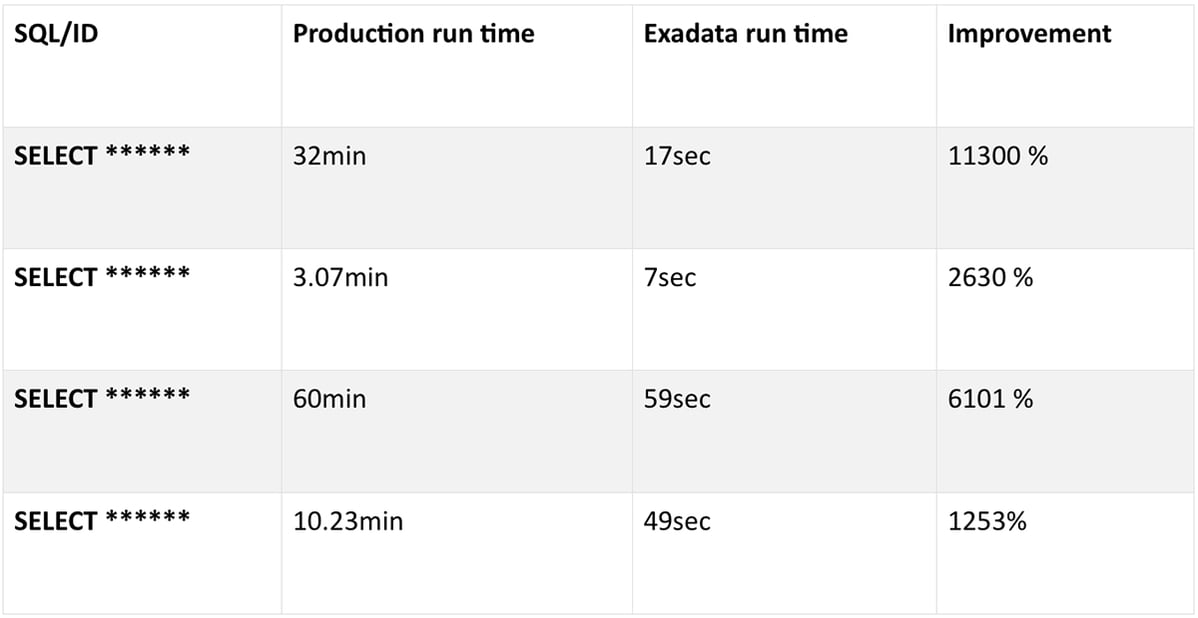- About
Getting to know us
- Services
- Managed Services
- Application Services
- Cloud Services
- Data Science
- Consulting Services
- Technology Solutions
Managed Services
Application Services
Data Science
Consulting Services
Technology Solutions
- Industries
- Resources
Resources
- Contact
- Contact us
Need more oomph from Oracle?
Contents
Since joining Explorer in 2010 and working with customers with varying sizes of Oracle estates there are 2 key drivers that push customers to want to talk to me; reducing costs and improving performance. I’ve already shared my thoughts on reducing costs in another blog and here I will cover some examples of how we’ve improved performance for customers.
I’d say that 75% of all Oracle performance issues I’ve encountered over the last 7 years have been down to the storage layer. The remaining 25% is a mixture of CPU, network and the real devil in the detail; poor code! The first challenge though is identifying the problem and Explorer have an extremely popular and free service that will help you do exactly that.
I’ve also found that the proliferation of multi-vendor technology stacks over the last decade contributes towards two problems with Oracle performance issues;
- When performance problems arise, identifying the problem takes time and often becomes political where each team tries to protect their own nest. “It’s not us” is a statement I’ve heard countless times over the last few years. The result? A lack of accountability within the stack to ensure optimal performance for workloads. The answer? Simplify the root cause analysis where a vendor solution “owns” the problem from apps to disk.
- With the preference to standardise on “best-of-breed-for-budget” technology at each layer to accommodate multiple and different types of workloads and applications there is a risk that business critical systems demanding extreme performance just cannot cohabit with general purpose systems. The result? Business critical systems that demand system resources (10% of the landscape) swallow up the resources needed for 90% of the remaining general purpose workloads. The answer? Separate high end systems to sit on dedicated infrastructure to allow scalability and remove bottlenecks.
At Explorer we help customers identify these issues but importantly provide the guidance and expertise that deliver change and improvement. It all starts with an Oracle Architecture review.
Oracle Architecture Review
An Architecture Review is a free service provided by Explorer designed to address any of the following;
- Sanity check Oracle environments for performance, availability, operational management etc.
- Identify performance bottlenecks and present solutions to resolve
- Map “as-is” architecture design to “to-be” business requirements
- Assess business continuity and disaster recovery policies including gap analysis
- Security assessment of complete stack including gap analysis
By providing this Architecture Review service with a License Advisory Service we can also recommend ways to reduce cost and avoid future costs arising from compliance risk.
Once the Architecture Review is complete and we have identified performance bottlenecks we’re able to make recommendations on how to resolve. As previously stated, storage is often the culprit in need of addressing but CPU, connectivity, networking and code could also be the root cause.
So what are the most common recommendations from an Architecture Review?
There is no quick answer to this. The point is we don’t have any particular product focus. The benefit of working with consultancy & service providers is that we have long term customer value and retention in mind so recommending a particular vendor solution based on whether it’s the flavour or month or not is naïve. We recommend solutions based on their value and are justified based on evidence. For example;
A real customer of ours assessed Exadata as a solution to migrate their business critical Databases to. Dramatic improvements were demonstrated during a Proof of Concept with some examples below;
As you can see, Engineered Systems can deliver extreme performance improvements to organisations without the price tag they once had 3-4 years ago. This is just one example – Cloud, 12c Options, Storage, Servers and even our development services for rogue code can all help resolve performance issues and put you on a platform fit for purpose.
If you’re interested in learning more about different options and methods of improving performance, why not contact myself or a member of the Advisory Services team.
Author: Jon Lingard
Job Title: Practice Director
Bio: Jon is a member of the Oracle sales team and works with customers from start-ups, SMEs to large corporations to gain maximum value from their investment in Oracle technology. Jon works with the technical and development teams to shape solutions based on customer demands and develops long lasting customer relationships based on his open and trustworthy approach.

.png?width=250&name=stonewater-logo%20(1).png)

